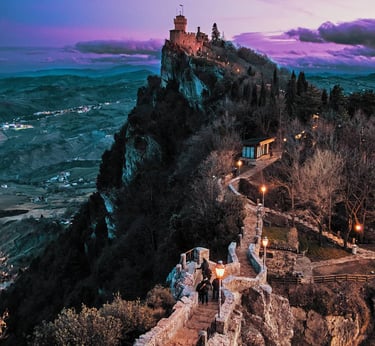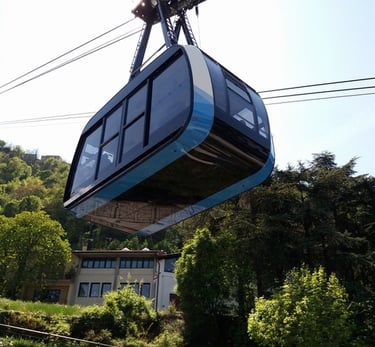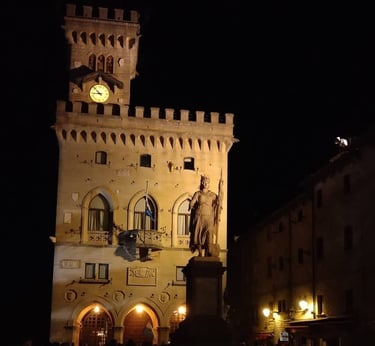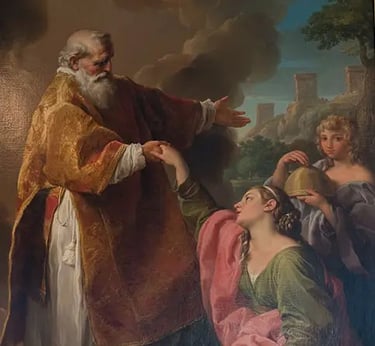Passo delle Streghe
If you’re walking around the historic centre of San Marino, you can’t miss this breathtaking spot.
Legend has it that during the witch hunts, people suspected of witchcraft were pushed off this very ridge...
A bit dark – and probably not true.
What we do know for sure is that from up here, you’ll enjoy one of the most stunning views in San Marino. On clear days, you can even see the sea shimmering in the distance. Pure magic (no witchcraft!).


Cable Car (Funivia)
One of the most scenic ways to reach San Marino’s historic centre is also the most convenient.
The San Marino cable car connects Borgo Maggiore to the heart of San Marino Città in just under 2 minutes, offering spectacular views of the Adriatic coastline along the way.
The lower station is located in Borgo Maggiore and has a car park accessible from Via 28 Luglio and Via Oddone Scarito. The upper station, 166 metres above, sits right next to Contrada del Pianello, making it a perfect gateway to the Old Town.
With frequent rides every 15 minutes and extended summer hours, it's a great alternative to driving or hiking uphill.
Ticket prices:
Round trip: €5.00
One way: €3.00
Discounts available for students, seniors, and holders of the "Tutto San Marino Card"
Note: Dogs are allowed on board, as long as they’re on a lead and wearing a muzzle (or inside a carrier).
Fun fact:
The original funivia opened in 1959, and since then, it has carried over 14 million people to the top of San Marino’s mountain. The most recent renovation was in 2017, with brand new cabins and upgraded safety systems.


Parliament (Palazzo Pubblico)
The Palazzo Pubblico - literally “Public Palace” - is the beating heart of San Marino’s political life.
This is where the country’s most important ceremonies take place, including the twice-yearly investiture of the Captains Regent (the heads of state), held every year on April 1st and October 1st.
Standing proudly in Piazza della Libertà (also known as Pianello), the palace was built on the site of the original Domus Comunis Magna, which dates back to the late 1300s. The current structure was designed in the 19th century by Francesco Azzurri, a Roman architect and president of the Accademia di San Luca, and inaugurated in 1894 with a speech by poet Giosuè Carducci, who famously praised San Marino as a land of “perpetual liberty.”
Later, in 1996, the building was carefully restored by world-renowned architect Gae Aulenti, to meet modern standards of safety and functionality.
What to look for:
The facade, with its richly detailed coats of arms representing the Republic and its municipalities.
A bell tower, topped with crenellations and featuring images of Saint Agatha, Saint Leo, and Saint Marinus, along with a bronze statue of the founder himself.
The interior atrium, filled with inscriptions, trophies, and busts of historical figures — including Carducci himself.
And of course, the Council Hall, where San Marino’s 60 parliament members gather to govern the Republic. Above their seats, a large fresco of Saint Marinus reminds them of his legendary words:
“Relinquo vos liberos ab utroque homine” – “I leave you free from both men” (referring to the Pope and the Emperor).
The palace also houses the Congress and Audience Hall, as well as the Scrutiny Room, which overlooks the square and connects to the upper terrace and tower.
And just outside? You’ll be standing above ancient rainwater cisterns once used as the town’s reservoir. It’s more than just a landmark: it’s a symbol of San Marino’s centuries-old democracy and unbroken independence.


National Museum (Museo di Stato)
Opened in 1899, the National Museum of San Marino is a treasure trove of history, culture, and art. Since 2001, it has been housed in the elegant Palazzo Pergami Belluzzi, right in the heart of the Old Town.
Inside, you'll find nearly 5,000 items — from archaeological relics to fine art, historical coins, and fascinating objects tied to San Marino’s rich heritage.
What to see:
Archaeological finds from the Neolithic to the Early Middle Ages, including the iconic bronzetti votivi from “Tanaccia” and the gold Domagnano Treasure
Ancient coins and medals from 1865 to 1938
Paintings and sculptures by Italian masters such as Guercino, Pompeo Batoni, Elisabetta Sirani, and Bernardo Strozzi
Art from Egyptian, Etruscan, and Roman civilizations
Religious artefacts from the Santa Chiara Monastery and the ancient Pieve di San Marino
Fun fact:
The museum’s founding donor was Count Luigi Cibrario, an Italian minister and advisor to the Sammarinese government. His contributions inspired many others — politicians, writers, and admirers of San Marino — to donate valuable items from all over the world.
Layout:
Ground floor – International donations
First floor – Local archaeological finds and numismatics
Second floor – Art and objects connected to the Republic’s myth and history
This museum is more than just a collection — it’s a celebration of San Marino’s identity, proudly preserved through centuries of diplomacy, culture, and independence.


© 2025 Perpi Ltd - “San Marino is...” and sanmarino.is are trademarks of Perpi Ltd.
Company address: 159A Portnall Road, London, United Kingdom.
Connect








